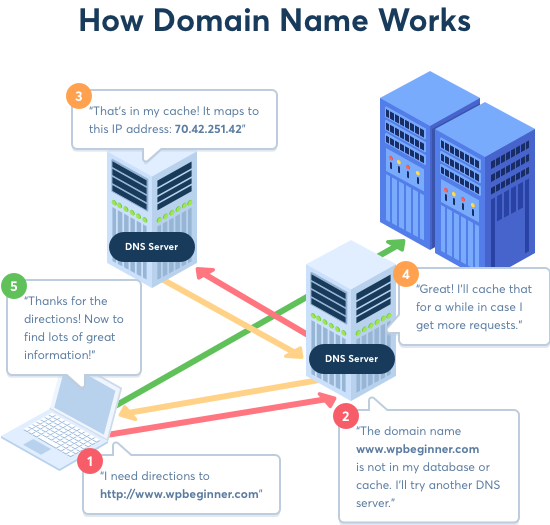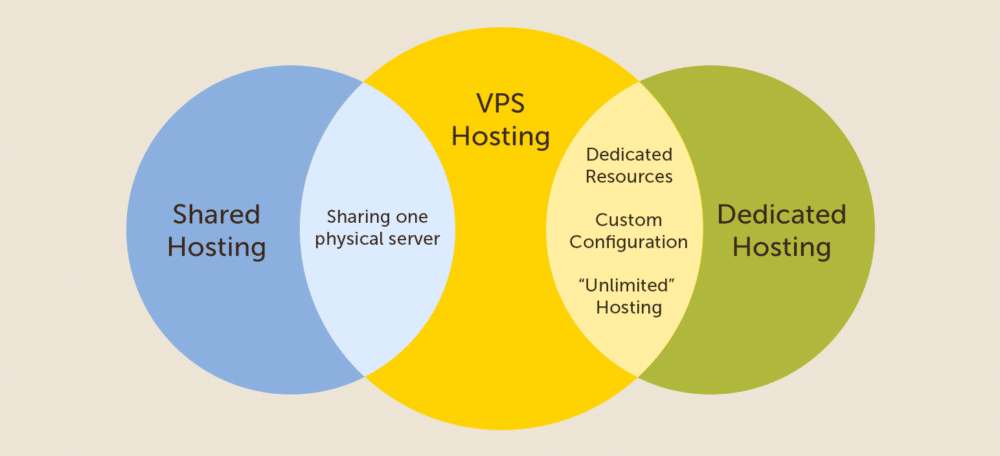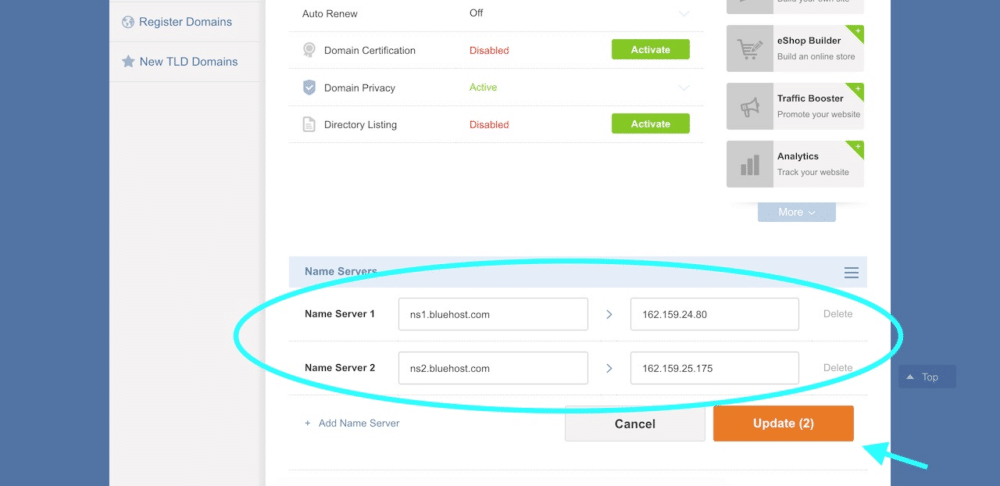Every website needs to be hosted. It’s a requirement.
As a freelancer, hosting a website is the ONLY way to get your website published and visible to everyone on the web. If you sell a product or offer freelance services, it means you’ll be able to attract customers/clients to your website and make money.
You’ll find a lot of information on the internet about web hosting. The type of web hosting solution you’ll need depends largely on multiple factors — such as the type of website, the size of your website, and so on.
That’s why I created this guide with you in mind. Even though it’s quite easy to host a website, it can be daunting for freelancers.
Regardless of the type of website you’re creating, I’ll show you exactly how to host it in 4 simple steps.
What Does it Mean to Host a Website?
Hosting a website is the art of uploading your website files on a server. This server is a special computer that’s always active and running. It ensures that your website files are publicly accessible on the web, so anyone with the URL or address can visit it.
The web server is a special set of software programs that are installed on a computer to make the website accessible to the public.
The primary job of a web server is to receive incoming requests, process them, and respond by rendering the requested page to the user’s browser (e.g., Chrome, Firefox).
What Do You Need to Host a Website?
In this guide on how to host a website, it’s important to know the tools of trade. Yes, before you can host a website to the web server, you’ll need these two elements:
Web hosting service providers are companies that provide ready-to-use web servers where you can host your website.
They handle all the technical stuff associated with your website.

In turn, they provide website owners with tools and easy-to-use features to effectively manage their hosting.
A domain name is the address, identity, or location of the self-hosted website. It’s the only means by which users can reach or visit the website to view its content. That’s why you need to register a domain name that’s easy to remember and spell.
Medium.com is a great domain name. It’s both memorable and easy to spell, isn’t it?
Getting your website live can be tough work, and it can also be expensive. However, James from UKWebHostReview has highlighted some providers that will host your website for free, saving you some money. However many so-called “free” web hosts come with many disadvantages like slow loading times and limited functionality.
Do this first before you host a website
In this section, we’ll cover where and how to buy/register a domain name. When you’re learning how to host a website, there are a few things to do first.
Since a domain name is the exact website address that users input in the browser to visit your website. For example, typing ‘Millo.co’ will successfully bring you to this website.
The illustration below shows you how domain names work.
When you’re ready to buy a domain name, there are licensed companies that you must use. They’re responsible for managing domain name registrations.
Here are 3 sites you can buy your domain from:
1) Domain.com: This is one of the oldest domain registrars online. The company allows you to register a new domain using top-level extensions (such as .com, .net, .org, etc.) or you could use the newer extensions — like .design, .tech, .online, .fun, etc.
The cost of registering a domain name with this registrar costs $9.99 – $12.99/year.

2) Bluehost: Bluehost was started in 1996 and to this day remains one of the most popular WordPress hosts. They have earned the title of #1 web hosting for small businesses. They have 24/7 expert support and a 99.9% uptime guarantee, which makes them an incredibly reliable choice for any startup business, digital product creation or download site.
With all these reasons and more it is no wonder that WPBeginner users are given an exclusive 63% off discount, including Free Domain, Free SSL, Free Site Builder and Free 30-day trial plus they will also receive a free domain name if they decide to host their website with BlueHost.
3) Namecheap: If you’re looking for cheap domain names from a company that offers 24/7 support, then Namecheap should come to mind.
I have registered 10+ domains here and have no regrets whatsoever. It’s well-received by thousands of online entrepreneurs. This registrar has a ton of helpful resources on how to host a website — no matter the type.
Namecheap is rated 4.7 out of 5 by 1.5 million customers.
TLDs cost $8.88 – $10.98/year.
Note: As you read further, I’ll show you how to get a domain name at no cost. If you’re just getting started and don’t have the budget, this might be a great option.
But first, let’s dive into the steps on how to host a website for freelancers.
How to host a website in 4 steps
If you have never hosted a website before, here’s the step-by-step process on how to host a website.
Step #1. Decide which type of website you are building
Not all websites are created equal. The type of website you intend to create will determine what type of hosting solution you’ll use.
However, no matter the type of website you want to create, it should typically fall into two categories:
- Static websites
- Dynamic websites
Static or basic websites
These are websites with simple HTML pages. Static websites can have one or many pages. These websites are most suitable for freelancers, personal blogs, and small business websites.
You can learn basic HTML lessons from YouTube or take some online courses to learn how to build static websites.

Once that’s done, you can upload the pages and their files to the web hosting server using FileZilla (or other FTP software).
Note: FTP means File Transfer Protocol. A piece of software that helps you transfer files that reside on your local computer to the web server or public directory.
When it comes to Static or Basic websites, you need to continually make changes to your website and edit pages using your computer. Then you must re-upload the pages and files to the web server again.
These websites are referred to as “Static” because they can’t be modified dynamically on the web.
Of course, static websites are easier to create and cheaper than dynamic websites — because they do not require interactivity, eCommerce, or advanced functionality.
Dynamic websites
Most dynamic websites function as CMS like WordPress, Wix, or Shopify, which makes it easier for the user to directly add, delete, and modify content (i.e. text, photos, videos, design), and give visitors to the website the chance to leave comments and start discussions.
Also, these websites provide a ton of study resources, knowledge base, and even user-generated content.
Step #2. Select your web hosting plan
There are 4 different types of web hosting plans to choose from. Let’s go through each of these hosting solutions and why you may need them:
Shared hosting
Shared hosting is the most popular hosting solution available to most freelancers who want a simple website to showcase their portfolio. It’s cheap and doesn’t require many technicalities. When I first discovered how to host a website, shared hosting was the most popular solution at the time.
In shared hosting, you’re paying for a physical server that has already been shared with other website owners. Just keep in mind you’ll be given your own separate account secured with login credentials.
Shared hosting is cost-effective because you’re not the only website owner that’s paying for the web server. It’s actually shared between you and others.
If you’re creating a small website, a static website with 1 – 20 pages, simple blogs, shared hosting is most ideal for you. Small businesses can also benefit from this hosting solution.
- Pricing: The starting cost ranges from $2.65 – $7.99/month
- Who is it for: For freelancers and beginners starting a new blog, basic sites, and small business website.
- Our recommended shared hosting provider: Bluehost or Hostgator
VPS hosting (Virtual Private Server hosting)
In VPS hosting, your website is stored on a powerful web server, which is carefully divided into several virtual compartments.
Each virtual compartment is configured as a standalone server so that each unit can function independently. It’s a hybrid of shared hosting and dedicated hosting as illustrated below:
If you’re concerned about security but have a limited budget, VPS hosting might just be the right solution for you. Yes, it’s cheaper than hosting with a dedicated server.
VPS hosting may function as a shared hosting environment, but it offers a set of helpful resources to handle huge traffic spikes. So if you’re expecting a ton of traffic to your website at some point, you might want to prepare and host with VPS.
When using various prospecting techniques to onboard the right customers, it’s important to prepare your website and make it accessible, fast, and professional.
You can efficiently manage your VPS hosting from your control panel (cPanel). Hence, you get the best of dedicated resources and the low cost of shared hosting.
- Pricing: Starting price ranges from $7.99 – $29.99/month
- Who is it for?: It’s ideal for eCommerce stores, medium-sized business websites, popular blogs, etc.
Our recommended VPS hosting company: DreamHost (starts at $10/month)
Dedicated hosting
With dedicated hosting, you have an entire server to yourself. It’s a faster and more secure web hosting solution. It’s rent-and-use hosting. As a freelancer who’s learning how to host a website, ignore dedicated hosting until you have the experience and budget.
Of course, it’s more expensive than other hosting solutions.
If you have a high-traffic website or user-generated content site (such as forums, active blogs, and social networks), this might be the most suitable hosting package for you.
Larger businesses can also use it — since it allows for maximum customization, configuration, installation, and flexibility.
A dedicated server hosting gives you the entire server dedicated to your own website. You get all the resources of the server, advanced tools for server management, the ability to install your own software, and even your own operating system.
As a website owner, you’ll be responsible for managing your own server. If you don’t have technical skills in server management, you should steer clear of dedicated hosting.
Use it only when you have the experience, a high-traffic website, and require high-performance websites (in terms of speed).
- Pricing: The starting price ranges from $79.99 – $599/month.
- Who is it for?: Popular eCommerce sites (like Amazon, Zappos), hugely popular media sites (TechCrunch, Business Insider), enterprise-level businesses, and the like.
- Our recommended Dedicated hosting company: SiteGround or Bluehost.
Cloud Hosting
Cloud hosting is a high-end hosting solution for business websites.
In Cloud hosting, the provider allocates multiple virtual servers (clouds) and provides tools for them to work together to effectively host a website or a set of websites. It can handle any level of traffic spikes.
A cloud-hosted website is versatile and not limited to a single server. In fact, the resources that the website uses can become smaller or expand dynamically, depending on the level of traffic the website is getting.
- Who is it for?: Large websites like magazine websites, eCommerce brands, newsletters, and blogs, and online tutoring platforms like Udemy and Coursera can use cloud-based hosting.
- Cloud hosting is relatively cheap. Pricing starts at $4.99 – $30.99/month.
Managed WordPress hosting
Managed WordPress hosting is a hosting service designed specifically for WordPress.
It’s a form of a concierge service for every WordPress user who wants their website to be fully managed by a professional team.
Keep in mind that managed WordPress hosting isn’t necessarily a type of web hosting. It mostly falls into Shared, VPS, Dedicated, or Cloud hosting services.
The only difference here is that another company is offering you their expertise. They’ll take care of the backups, updates, and caching of your website.
If you’re busy with other aspects of your website — such as creating content, you can focus on those while you let another company manage the hosting for you.
Also, if you’re not an experienced WordPress user (and you hate upgrading plugins, themes), and being in charge of security, you can let another company assist you.
How much does Managed WordPress hosting cost? Let’s find out.
- Pricing: The cost from $35 – $59.99/month
- Who is it for?: WordPress blogs, membership sites, popular blogs, etc.
- WP Engine and Flywheel are our favorite Managed WordPress hosting providers.
Step #3. Change Your DNS Address
The web hosting provider and hosting type you choose eventually will be determined by your budget.
After all, no rule says you can’t use dedicated hosting for static websites — provided you can afford it.
Once you’ve purchased your hosting package, it’s time to switch your Name Servers (also referred to as Domain Name Servers or DNS).
Before your website can successfully function on the public server, your domain name needs to sync with the DNS. It’s a necessary step in this entire process.
So how do you change your DNS? Well, the process is similar no matter the web hosting provider you choose. Here’s how to change DNS via Hostgator:
- Navigate to your Domain Control Panel
- Enter your registered email address and password.
- Click on the Domain Name you wish to change the Name Servers.
- Then click on the Name Servers in the Domain Registration section.
- Change the existing Name Servers with the ones you got from your current web host. Then click on the Update Name Servers button.
Note: You can register your domain name with a third-party registrar outside of the hosting provider. In this case, you’ll need to log in to their (domain registrar) Control Panel, copy the DNS of your web host and update accordingly.
For example, if you registered your domain name with Namecheap, but you’re hosting with Hostgator, it means you’ll copy the DNS from Hostgator, log in to your Namecheap account, select the domain in question, and update the DNS records.
After you have successfully changed your DNS with the domain registrar, you’ll need to be patient for about 24 – 48 hours. This will enable your website to start resolving to the hosting servers.
What to consider when choosing your website host
There are several factors to consider when choosing a web hosting service or provider. Let’s run through the key factors:
Server uptime & reliability
You don’t want to spend all night monitoring your website to ensure it’s active and live. That would be a disaster, considering “you need adequate sleep to achieve the perfect Work-Life Balance,” according to this study by Eachnight.com.
Essentially, you want your website to never go down (not even a few seconds of downtime).
Therefore, you need to choose a web host with a powerful server — equipped with good hardware and uninterrupted network connections.
Make sure you choose a web hosting provider that’s reliable and offers a 99.5% and more uptime score. Any web host that’s below 99% shouldn’t be trusted.
Price
Price is the most obvious factor we all consider when choosing a hosting provider. But it shouldn’t be the only defining factor.
Here’s why:
You get what you pay for. You don’t have to jump on the cheapest web hosting service you find — because it may not necessarily offer the best uptime and support.
A hosting provider that charges $2.00/month or less won’t offer dedicated support and other essential add-ons on its server. Make sure you consider the features that each host provides, then you can compare prices better.
Speed
Google, in particular, is so mindful of page speed. Google will always prioritize the pages that load up faster and deliver the best user and customer experience.
What loading speed does your web hosting service offer? It’s an important factor to keep in mind.
Because the server speed will determine whether or not visitors will leave your website. Ecommerce websites and blogs, in particular, need to be insanely fast.
Popular sites like Reebok, eBay, 3Wishes, and Zappos receive millions of monthly traffic and make a lot of money because users don’t have to wait for more than 3 seconds before the pages load up quickly before purchasing products.
If you have plans to build your email list (very important) eventually and host webinars to engage your customers, make sure your website and landing page are fast.
Otherwise, visitors will not be happy to stick around and subscribe to your email list.
Monthly traffic
You may not know this already but some web hosting providers are limited in the amount of traffic they send to websites each month.
This could mean that your website may be inactive after a specific amount of access. In worse cases, you’ll be charged an additional fee for “extra visitors” or your website will be dead until the next cycle (i.e., next month).
Therefore, you need to read in between the lines. Go with a web host that offers unlimited data traffic. This will ensure that your website is never down no matter the traffic spikes it receives.
Support
Web hosting is technical, so you’ll always need some help along the way. You’ll always encounter technical issues that your web host must resolve.
Truly, customer support is an important consideration — it’ll make the difference between getting an issue resolved quickly or having your website offline for several hours (even days).
Look out for 24/7 support via email, phone, and support tickets. An active community on Facebook, Slack, or within the site is also essential. If your web host doesn’t offer these multiple support options, look elsewhere.
Conclusion
There you have it, the step-by-step guide on how to host a website.
This could be the beginning of something great in your life. Because a self-hosted website is a step towards building a profitable online business.
Keep in mind that hosting your freelance website, for example, doesn’t guarantee traffic.
If you need the right people to visit your website, you need to employ practical online marketing strategies such as guest posting, SEO, social media marketing, paid advertising, YouTube marketing, and so on.
Keep the conversation going...
Over 10,000 of us are having daily conversations over in our free Facebook group and we'd love to see you there. Join us!





